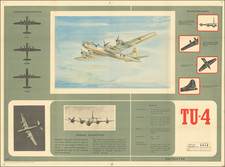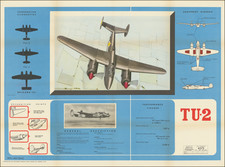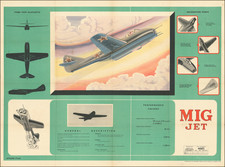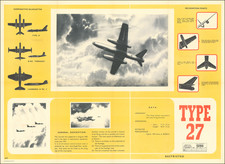A detailed diagrammatic poster prepared by the Ministry of Supply in February of 1949, elucidating the specifications and design of the Yakovlev Yak-15 turbojet fighter. Towards the end of World War II, the Soviet Union started to develop jet planes. After the early Lyulka-produced engine proved unreliable, Stalin ordered aircraft engineers to turn to the Junkers JuMO-004 and BMW-003A engines. After peace treaties mandated German demilitarization, technical teams from Junkers and BMW, the most notable of which was Junkers' Ferdinand Brandner, were transferred to the Soviet Union for research and development. The Yak-15, itself based on the piston-engined Yak-3 to speed up development, was fitted with the reverse-engineered and modified JuMO-004, under the designation Klimov RD-10. A first batch of 50, all single-seaters, participated in a May Day flypast in 1947.
The Yak-15 had a relatively short era of use, serving mostly as a trainer, as Soviet engineering prowess rapidly increased.
Soviet Aviation Industry
The Russian Empire's entry into aviation started in 1910 with Igor Sikorsky's S-1; the field proved a less capital-intensive endeavor than improving the rail network across the vast country. After Stalin's push for industrialization in his First Five-Year Plan, his Second Five-Year Plan (1932-1938), which gave heavy industry, particularly the steel industry, top priority, helped further the Soviet Union's aviation industry. In 1931, a cohort of 65 students was sent to top universities in the United States. The most notable among them was Stanislav Shumovsky, who attended MIT and remained in the country for over a decade, escorting prominent engineers such as Andrey Tupolev, Sergei Ilyushin, and Pavel Sukhoi around numerous universities, research labs, and aviation facilities. Stalin called for his engineers to "fly higher, farther, faster" and in 1933 had August 18th designated as the date of a yearly Aviation Day, the same year the United States officially recognized the Soviet Union. In 1936, the Soviet government was able to secure a license from Douglas to produce DC-3, under the designation Lisunov Li-2. By the end of World War II, Ilyushin's Il-2 became the most-produced combat aircraft, with 36,183 manufactured.
"How Reds Used Captive Brains." Life. May 27, 1957.











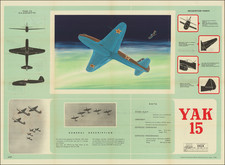
![(Cold War-Soviet Aircraft Identification) Russian Built B-29 [ Tupolex Tu-4]](https://storage.googleapis.com/raremaps/img/small/96736.jpg)
